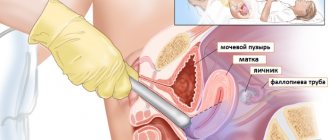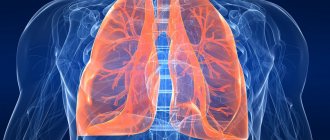According to WHO, smoking is the main cause of cardiovascular and respiratory diseases. Smoking is the cause of lung cancer in 90% of cases, as is 25% of heart disease.
Moreover, this applies not only to the smoker himself, but also to his family members.
With passive smoking, a person receives the same amount of toxic and carcinogenic substances as when smoking 3-4 cigarettes a day. Children under 5 years of age whose parents smoke suffer from ARVI 4-8 times more often than other children.
Such children in adulthood, even if they do not smoke, suffer from chronic bronchitis, allergies and pharyngitis. Given that 40% of children have one or both parents who smoke, all have health consequences associated with exposure to tobacco smoke.
Every year, more people die from the consequences of smoking than from AIDS, drug addiction, car accidents and murders combined. For this reason, a person who smokes needs to undergo periodic examinations to identify any changes in their health.
How the lungs change
Healthy ones have a lobed pattern in the shape of pyramids, separated from each other by partitions of connective tissue. Covered with tiny specks of dust, these separators become brighter and the lobules seem to be outlined with a graphite pencil. The severity of the pattern varies and completely depends on the cause of the plaque.
The respiratory organs of persons most susceptible to contamination are:
- residents of megacities;
- living in houses with stove heating;
- drivers of diesel vehicles;
- breathing cigarette smoke.
In a smoker, in addition to the connecting septa, soot also covers the lung tissue itself, the lumens of the bronchi and bronchioles. Soot accumulates and forms a thick layer over time of smoking. The lungs themselves become smoked in color. This can be seen in the autopsy photographs from the medical examiner's office.
Natural causes of pollution
Modern reality, with its technological progress, factories, plants, cars, dictates the conditions for widespread inhalation of dirty oxygen by people. This is a global problem that is of anthropogenic origin - it arises due to the influence of people and society on nature. Tiny suspended particles and aerosols are constantly present in the atmosphere. Scientists estimate that their weight annually reaches approximately 100 million tons. Considering that many people live in villages where the air is much cleaner, the main consumers of dirty oxygen are residents of large cities.
According to the World Health Organization, there are 70% of the total population. More than half of the dust grains appear in the atmosphere as a result of incomplete combustion of fuel - hydrocarbons, the combustion of which produces soot. The size of each particle is on average approximately 1 micron.
Human lungs are designed to filter foreign substances larger than 5 microns. Soot particles of smaller diameter easily penetrate inside and remain in the lung tissues.
Main symptoms
The main symptoms of chronic bronchitis are cough with expectoration of sputum. In addition, distant wheezing, heaviness and congestion in the chest, and shortness of breath during exercise may appear. People who smoke often have a cough with sputum all year round, and against this background, exacerbations of bronchitis periodically develop3.
Initially, cough occurs mainly in the autumn-winter period, significantly decreasing or completely disappearing in the warm season. In the absence of treatment, the cough progresses over the years and becomes year-round, exacerbations with the appearance of purulent sputum occur more often, last longer and are more severe, and shortness of breath gradually develops during physical exertion.
During exacerbations, the cough usually intensifies, the volume of sputum increases, although in the first days it may decrease; At the same time, coughing becomes difficult. During an exacerbation, the color of sputum often changes to darker: yellow, green or brown. Exacerbations of bronchitis may be accompanied by shortness of breath on exertion or a feeling of chest congestion or heaviness, even in those patients who do not experience such sensations in a stable condition4.
Pollution from inhalation of tobacco smoke
Puffs of cigarette smoke contain products of incomplete combustion of a cigarette:
- glue;
- paper;
- tobacco;
- carbon monoxide;
- alcohol;
- ketone;
- ether;
- aldehyde.
The resulting soot when they burn hangs in the air, concentrating directly above the smoker, next to his respiratory tract. This ensures uninterrupted flow of soot into the respiratory tract of the smoker and persons located in close proximity to him.
Cilia, the thinnest hairs covering the ciliated epithelium of the bronchi, help the lungs purify the incoming air. Actively moving, they create the role of a protective barrier, preventing the penetration of potentially dangerous substances into the alveoli: dirt, microorganisms, dust. All penetrating pathogenic agents adhere to the mucus surrounding the cilia and are carried out by them when moving.
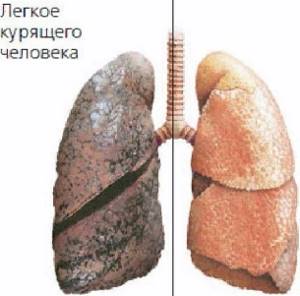
Cilia have a pronounced sensitivity to damaging mechanical and chemical factors contained in large quantities in cigarette smoke. Permanent damage from systematic use of tobacco products leads to the replacement of ciliated epithelial cells with basal cells. As a result, more mucus is formed, and clearing it out makes it increasingly difficult to cough up. This is a sign of the formation of chronic bronchitis.
Consequences for a passive smoker
If you live or work in a community where people smoke, your lungs will also suffer irreparable damage.
Consequences of passive smoking :
- Damage to the respiratory system. The development of relevant diseases, including cancer.
- Detrimental effect on brain activity. Deterioration of memory, assimilation of information, and analytical abilities.
- Irritation of the mucous membranes of the nose and eyes. This leads to an increase in colds and vision problems, respectively.
The reasons for such severe consequences of smoke damage are obvious - the air that a smoker exhales contains the same toxic substances.
Lungs on X-ray
Tobacco users ask two main questions:
- Is it possible to see from fluorography that a person smokes? This worries young people who are afraid to admit their bad habit and hide this fact from their parents.
- What do the lungs look like on an X-ray image? This worries the older generation, who are worried about their health and worried about the future.
Fluorography can show changes in the pulmonary area with a sharp and rapid development of diseases:
- oncology;
- tuberculosis.
In other cases, the changes that occur in the respiratory organs against the background of addiction to tobacco products will be invisible to the eye.
An x-ray allows one to distinguish pathological changes in the bronchi and lungs in the image.
The pulmonary pattern changes in diseases of the organ such as:
- cancer;
- emphysema;
- chronic obstructive disease.
For the most accurate and complete diagnosis, it is recommended to conduct an R-study in two projections. Sometimes a thorough examination of the organ is required using bronchoscopy, computed tomography, and magnetic resonance imaging.

Myths about the dangers of smoking
Myth 1 . A smoker's lungs simply take on a darker hue. They cannot have resin on them.
Disclosure : A person who smokes actually develops tar on their lungs as a result of the constant intake of soot. However, it is worth remembering that people who work in hazardous industries, drivers of diesel vehicles, and even those who heat the room with a stove are susceptible to such harmful influences. Of course, in these cases the harmful effects on the body are less noticeable.
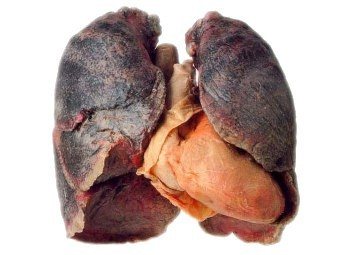
Myth 2 . The relationship between smoking and lung cancer has not been officially proven.
Disclosure : Yes, this is true, but before you stop worrying about your own health, it's worth paying attention to the statistics. Thus, only 10% of those who contract cancer have nothing to do with this bad habit.
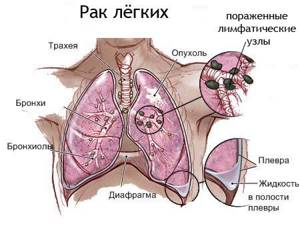
Myth 3 . People with a long history of smoking die from quitting.
Exposure : Unfortunately, the consequences of a harmful activity that a person has endured for many years (more than 30 years of experience) lead to death.
However, you shouldn’t “leave everything to chance”: quitting smoking now can give you several years of life.
Here lies additional motivation for young nicotine addicts: think about the consequences, because with prolonged smoking they will turn out to be much more serious than at first glance.
When is diagnostics required?
A fluorographic screening test is recommended for every healthy citizen to undergo annually to prevent the development of possible pathologies of the chest organs.
If there are alarming signs of the disease, you need to consult a doctor for diagnosis as early as possible, when the very first symptoms of illness appear.
The initial appointment is carried out by a therapist who:
- conducts an initial examination;
- studies the symptoms of the disease;
- refers for consultation to a pulmonologist;
- writes out a referral for an in-depth x-ray examination.
Diagnostic examination includes:
- x-ray examination;
- bronchoscopy;
- CT;
- biochemical and clinical analysis of sputum and blood.
Many medical professionals express the opinion that conducting research for no apparent reason leads to excessive medical intervention - overdiagnosis. Not only is this not beneficial, but it is also harmful to health.
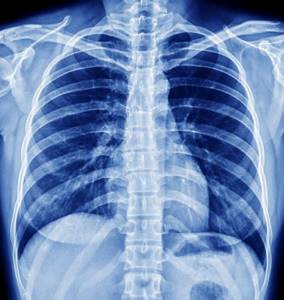
Effects of smoking on the lungs
How do the lungs of a smoker and an ordinary person differ at different stages of smoking? Let's look at this question:
With 1 year experience:
- The organ has already acquired a gray tint.
- According to recent studies, when consuming a standard pack of cigarettes, about a glass of tar accumulates in the human lungs.
- Immunity weakens: a person suffers from infectious diseases more often.
- A smoker gets tired much faster.
- At times you feel a slight tingling sensation in your chest.
What do lungs look like after 10 years of smoking?
- A colossal amount of harmful substances leads to spasms - the so-called smoker's bronchitis appears.
- Tobacco smoke has already had an impact on the organs of the digestive system - many people develop stomach ulcers.
- Not only the secondary pulmonary lobules are occupied, but also the functional tissue parts of the lungs.
- The skin looks much worse: a yellow tint and wrinkles appear.
- There are various tingling sensations and discomfort in the heart area.
15 years of experience:
- Now the smoky lungs are covered not only with tar, but also with green mucus.
- The brown color changed to black.
- The ability to conceive a child in women who smoke is reduced by 3-5 times compared to non-smokers.
- The risk of developing and developing a cancerous tumor is several times greater than that of a healthy person.
- 90% of tuberculosis patients are precisely this category of people.
Smokers with 20 years of experience or more:
- A noticeable deterioration in the blood circulation process, disruptions in the functioning of the heart.
- Pulmonary emphysema develops.
- Serious dental problems appear - deep caries, periodontal disease, tartar.
- The risk of diseases such as Buerger's disease, thrombosis, and stroke is extremely increased.
- The absorption of calcium deteriorates significantly, and as a result, diseases of the musculoskeletal system develop.
Lung restoration at home
The human body has restorative and adaptive properties. By completely giving up tobacco, it is possible to improve the functioning of the respiratory system.
It will take many years for it to fully recover, but you can feel better within the first week. The activity of the cilia is restored within up to five days after completely quitting cigarettes, and the cleansing function of the organ is resumed.
While at home, the patient is able to help his body overcome the negative consequences of smoking and promote health.
To do this, it is necessary to create favorable conditions for the pulmonary system. These methods include:
- Sports and breathing exercises. They enhance restoration and metabolic processes in tissues, strengthen the immune system, and give a charge of vigor and good mood.
- Organization of proper nutrition. Fills with vitamins and minerals important for the normal functioning of the body.
- Taking medications and herbal medicine. Stimulate reparative processes.
The combination of several methods leads to a speedy recovery.
Pathogenesis
Smoking disrupts the functioning of the cilia that cover the inner lining of the bronchi (bronchial epithelium) and causes excessive mucus formation in the bronchial wall, and it does not matter what exactly the patient smokes: pipe tobacco, cigarettes or marijuana. Thus, under the influence of tobacco smoke components, non-infectious inflammation develops in the bronchi. In addition, nicotine causes spasm of the muscular lining of the bronchi (bronchospasm). These processes are expressed in the appearance of a cough with phlegm, and sometimes shortness of breath or a feeling of chest congestion or “heavy breathing.” The accumulation of sputum in the bronchi can cause distant wheezing, which the patient hears himself when inhaling or exhaling4.
Similar changes in the bronchial tree can occur not only with smoking, but also with prolonged exposure to other unfavorable factors: long-term inhalation of industrial smoke, for example, during welding, soldering, contact with combustion products, etc.5, therefore, before making a diagnosis, a detailed conversation between the doctor and the patient to find out all the possible causes of bronchitis.
Cleansing the respiratory system
A few days after smoking the last cigarette and not returning to the bad habit, the lungs begin to cleanse themselves. Without any intervention, it will take up to one year to feel significantly better. It is within the power of the convalescent to speed this up.
This will require strict adherence to six true rules:
- A complete cessation of cigarettes and no return to them. Quitting little by little or smoking occasionally will not work. Even one cigarette that interrupts the recovery period throws the patient far back in his recovery journey. The body again begins to show the corresponding symptoms and reactions to cigarettes. All the effort spent is wasted.
- Breathing fresh air. The apartment, house, room in which the person is located should be filled with it. Frequent ventilation always has a beneficial effect, a breath of fresh air only brings benefits. A cough that gets worse in the open air is not dangerous. It indicates the cleansing of the body, the removal of toxins from it. The airways are cleared by coughing, pushing out the remains of unnecessary microparticles. This means that the restoration is successful.
- Avoiding contact with smoking friends and random people. Passive inhalation of tobacco suspension is no less evil. In the company you can break down, feel the craving for smoking with renewed vigor and return to the bad habit.
- Refusal of alcohol. Drinking alcoholic beverages causes a smoker to have a strong desire to smoke.
- Maintaining moderate humidity. Carry out daily cleaning in the places of your primary residence: at home, at work. Especially in large accumulations of dust is observed in rooms with office equipment. The less dust remains on objects, the faster the cough goes away and it becomes easier to breathe. A smaller mass of dust substances around reduces the risk of inhalation and ensures freer breathing.
- Constant movement. Physical activity is life. And in combination with fresh oxygen, it is an indispensable means for maintaining health and tone. Visiting uncrowded places: parks, forests, river banks, where oxygen saturation occurs to the fullest. Walking, morning exercises on the street, slow jogging are the key to future success.
These rules help healthy people maintain their health, and sick people improve their health.
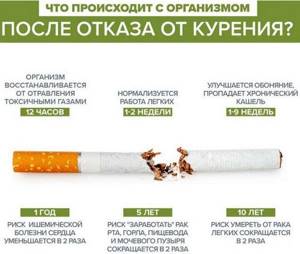
What happens to a smoker's lungs?
Let's imagine the usual smoking process:
- Tobacco smoke enters the nasopharynx, negatively affecting the mucous membrane.
- When you inhale, all the harmful substances in tobacco smoke penetrate the lungs.
- Next, mucus begins to be produced in the smoker's lungs.
- The lungs become inflamed from the inside, which makes breathing difficult and prevents oxygenation in the blood.
In a single case of smoking, healthy lungs will quickly eliminate the negative effects of a smoked cigarette and cleanse themselves of contaminants.
But the longer the smoking period, the more the risk of various diseases increases - from common colds to pneumonia with complications and cancer.
Composition of a regular cigarette:
- Methane, butane, toluene, methanol, ammonia, cadmium, hexamine.
- Arsenic, stearic and acetic acid.
- Carbon monoxide, paint.
During the study of the composition of cigarettes, not a single natural or beneficial component was found. This only confirms the harm of the addiction.
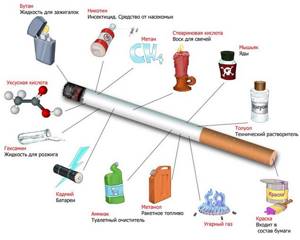
What we should know about nicotine:
- This is an element that is addictive. It has all the signs of a narcotic substance - stimulation of addiction in the smoker, his need to increase the dose and the so-called sedative effect.
- Nicotine is widely used in agriculture to kill insects - this is a fact.
- Nicotine is extremely harmful to others, since about 80% of the amount in a regular cigarette is inhaled by passive smokers, and only the remaining 20% by smokers.
Proper nutrition
A citizen’s complete diet depends on his age, gender, body weight, and physiological characteristics. It differs in what it contains:
- nutrients (fats, carbohydrates, proteins);
- minerals;
- vitamins
Garlic should be a must-have product on the menu. It acts as a powerful stimulator of cleansing processes. Apples and citrus fruits should also be included in the diet daily. They contain ascorbic acid, which is responsible for the regeneration of connective tissue.
Another essential nutrient is water. It should be ingested in its pure form up to 2 liters per day. Tea, coffee, cocoa, juices are not included in the calculation. Plain water washes away toxins and decay residues of dead cells. Its action is irreplaceable.
Why do people smoke?
All the disadvantages of smoking are countered by only 2 advantages - relaxation and the opportunity to communicate.
The body gradually gets used to a kind of ritual and associates it with a short break, a small reward for the work done during the day.
At the same time, there are simply no special substances in cigarettes that guarantee relaxation.
Unfortunately, the sedative effect is a myth that is supported by our own illusion, habit and the opinions of other smokers.
It cannot be otherwise, because due to habit, the body does everything in order to survive the stress that may occur if it is overcome.
Use of drugs
Medications are used only after consultation with the treating doctor. To improve breathing, general restoratives are prescribed:
- vitamins of groups A, B, C, E;
- minerals: potassium, selenium, zinc;
- Potassium orotate.
They stimulate metabolic recovery activity and metabolism.
A severe cough that occurs during smoking cessation is weakened by inhalation with a nebulizer and rubbing the pulmonary area. The following drugs are suitable for this: Salgim, Golden Star, Berodual, Lazolvan, Doctor MOM, Chlorophyllipt.
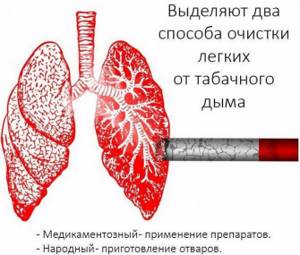
Prevention
To avoid possible unpleasant consequences, you should follow only two rules - brush your teeth regularly, using whitening pastes from time to time, and visit the dentist once every six months.
Smooth polished enamel prevents plaque from settling, leaving teeth looking well-groomed. With proper hygiene, the enamel does not have time to be “overgrown” with stones to such an extent that it reaches a terrible state within six months. The doctor's visit proceeds as usual, you can continue smoking. Although we highly recommend quitting.
Traditional medicine
The main folk methods of detoxification and cleansing:
- Bathhouse. A universal, common detoxifier.
- Herbal decoctions, infusions. Plants used: chamomile flowers, black currant leaves, sage, eucalyptus, birch leaves, pine needles and cones, sweet clover.
- Inhalations with leaves and roots. Herbal decoctions that have a characteristic, persistent, strong aroma help best. These are peppermint, wormwood, pine needles, cones.
The use of alternative treatment methods is recommended to be coordinated with the doctor and the prescribed course of treatment. They may not be beneficial in all cases.
Professional cleaning
Dentists offer several options to completely remove smoker’s plaque from teeth. Professional cleaning allows you to completely remove hardened deposits from the enamel and reduce the risks of caries and inflammatory gum diseases.
Types of professional dental hygiene:
- Mechanical cleaning. The doctor manually removes plaque with special scrapers. The work requires some effort, which is associated with possible damage to the enamel and gums. The method of mechanical cleaning is now almost never used precisely because of its traumatic nature.
- Dry cleaning. Special compounds containing acids and softening the stone are applied to the enamel. After curing, the plaque is removed. The method is notable for the fact that it allows you to simultaneously whiten your teeth. It is not recommended to constantly give preference to dry cleaning, since acids affect not only plaque, but also enamel.
- Ultrasonic cleaning. Using a special attachment, the doctor removes hard deposits that literally crumble under the influence of ultrasound. The main advantage of the technique is that it allows you to clean subgingival pockets (of particular importance if you are prone to periodontal disease and periodontitis). If your teeth are sensitive, anesthesia may be required. Ultrasonic cleaning makes it possible to remove all stones.
- Air-Flow. The principle of operation of the device is to supply a water-soda mixture to the teeth under pressure. The jet of the drug perfectly cleans the interdental spaces and subgingival pockets. Patients note a special feeling of freshness even during the procedure, after which the teeth become 1-2 shades lighter. No anesthesia is required.
- Laser cleaning. One of the most effective methods that allows you to remove smoker’s plaque as completely and painlessly as possible. The disadvantages of laser cleaning are the inability to clean subgingival pockets and high cost.
After cleaning, the teeth are ground and polished, the enamel becomes smoother, non-porous, which reduces the likelihood of rapid appearance of new plaque.
In practice, dentists use combined cleaning methods. The most common case is ultrasonic cleaning plus Air-Flow.
